Chinese Name: 四姑娘山 Pronunciation: Sìgūniang Shān
Height: 6,250 meters
Suggested Visiting Hours: Two days and one night
Mountain Tourist Area (above 700m): 591 square kilometers
Address: Mount Siguniang Town, Xiaojin County, Ngawa Tibetan and Qiang Autonomous Prefecture, Sichuan Province
| Attractions | Price | |||
| Peak Season (April 1st–November 30th) |
Low Season (December 1st-March 31st) |
|||
| Full Price | Half-Price | Full Price | Half-Price | |
| Shuangqiao Valley(Double-bridge Valley) | 80 CNY | 40 CNY | 50 CNY | 25 CNY |
| Changping Valley | 70 CNY | 35 CNY | 50 CNY | 25 CNY |
| Haizi Valley(Ocean Son Valley) | 60 CNY | 30 CNY | 40 CNY | 20 CNY |
1. Children below 1.2 meters are free of charge;
2. Children under 14 years old are free of charge on the International Children’s Day(June, 1st );
3. All tourists are free of charge on China Tourism Day(May 19th) in Haizi(Ocean Son) Valley, but those who engage in outdoor activities are not included;
4. Senior citizens aged 65 or over 65 (with valid ID card) are free of charge.
5. Senior citizens aged 60-64(with valid ID card) are free of charge on non-statutory holidays.
All preferential policies do not include outdoor tickets;
Half-price tickets are for people aged 60 to 65 on national statutory holidays (January 1st, Spring Festival (Lunar New Year’s Eve, the first and second days of the first lunar month), Tomb-sweeping Day (around April 5th), May 1st, May 5th in the lunar calendar, the Mid-Autumn Festival and National Day holiday (October 1st to 3rd).
| Contents | Price |
| Sightseeing Cable Car in Changping Valley | 20 CNY (one-way) |
| Sightseeing Cable Car in Shuangqiao Valley (Double-bridge Valley) | 70 CNY (one-way) |
| Outdoor Activities Tickets | 150 CNY (3-days effective) |
| Horse-riding Rent | 320 CNY |
| Note: Transportation facilities above are voluntary consumption. | |
| Attractions | Opening Hours |
| Shuangqiao Valley (Double-bridge Valley) |
7:30 - 16:00 (Spring and Summer)
7:30 - 15:00 (Autumn and Winter)
|
| Changping Valley | 7:00 - 15:30 (Spring and Summer) 7:30 - 15:00 (Autumn and Winter) |
| Haizi Valley (Ocean Son Valley) | 7:00 - 15:30 (Spring and Summer) 7:30 - 15:00 (Autumn and Winter) |

Located at the junction of Xiaojin County and Wenchuan County in Ngawa Tibetan and Qiang Autonomous Prefecture in Sichuan Province, Mount Siguniang is composed of four peaks—Mount Daguniang(‘peak of the oldest sister’), Mount Erguniang(‘peak of the second sister’), Mount Sanguniang(‘peak of the third sister’), and Mount Yaomei (‘peak of the youngest sister’). Their heights are 5,355 meters, 5,454 meters, 5,664 meters, and 6,250 meters respectively. Among them, Mount Yaomeifeng is the second highest peak in Sichuan Province.
Except for the four peaks, there are three valleys, namely Shuangqiao Valley(Double-bridge Valley), Changping Valley, and Haizi Valley(Ocean Son Valley). Mount Siguniang is also named “Four Girls Mountain” and is often referred to as the highest and most beautiful snowy peak. It is 220 kilometers away from Chengdu.
From north to south, the Mount Siguniang Scenic Spot includes Mount Siguniang, Mount Balang, Shuangqiao Valley(Double-bridge Valley), Changping Valley, and Haizi Valley(Ocean Son Valley).
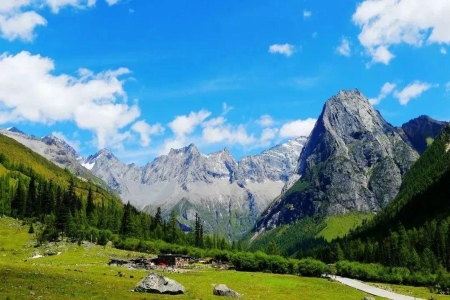
The natural ecology in the scenic area is well protected, with lush vegetation and a wide variety of biological species. There are more than 1,200 species of plants, which is rich in rare medicinal materials, such as gastrodia, fritillaria, cordyceps, etc. There are 31 species of animals under national protection where animal-lover tourists admire a lot, including giant pandas, golden monkeys, and snow leopards.
Mount Siguniang has been listed as a national-level scenic spot and a national-level nature reserve. As a World Natural Heritage, National Scenic Area, National Geological Park, National Nature Reserve, World Heritage Site of Giant Panda Habitat in Sichuan, and Top Ten Mountaineering Mountains, Mount Siguniang has become a popular tourist attraction for climbers at home and abroad in recent years.
With a subtropical monsoon climate and due to the large difference in topography, the climate in the area changes obviously with the change of altitude. The annual average temperature in the reserve is 5.9℃, and the average temperature at the top of Mount Siguniang is 17.1℃. The frost-free period is 78 days here. The mount has the annual rainfall of 931.5 mm, the obviously different dry and rainy season, uneven rainfall distribution in different regions and different seasons. Given sufficient sunshine as high as 51%, the annual average sunshine hours are 2,265 hours.
In 1994, Mount Siguniang was named “A National Key Scenic Spot”;
In 1995 and 1996, Mount Siguniang was approved by the State Council to be established as “A National-level Scenic Spot and Nature Reserve”;
In 1996, Mount Siguniang Scenic Area and its surrounding areas with Mount Jinshan and other places totaling 1,375.85 square kilometers were listed as “National Nature Reserves”;
In 2005, the Mount Siguniang Scenic Area was designated as “A National Geological Park”;
In 2006, the Mount Siguniang Scenic Spot was approved by the UNESCO as a part of the “World Natural Heritage Site of Giant Panda Habitat in Sichuan”.
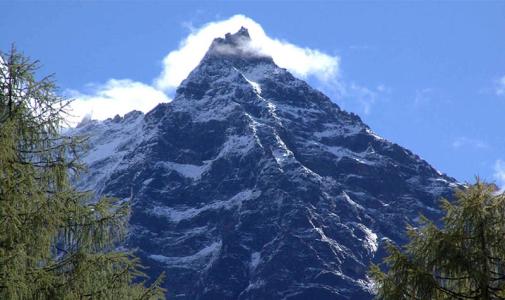
Mount Daguniang, located in the southernmost part of Mount Siguniang Secnic Area is 5,355 meters above sea level. Most of it is covered by alpine meadows below 4,000 meters. There are shrubs and forests on the lower part. Wild fungi, as big as the size of bowl and pot, are not easy to find, and no grass grows above 4,000 meters, besides, the rocks are very hard. There is a small amount of snow on the top of the mountain in summer, and it snows from October to April of the following year, and the snow on the mountain can be knee-high.
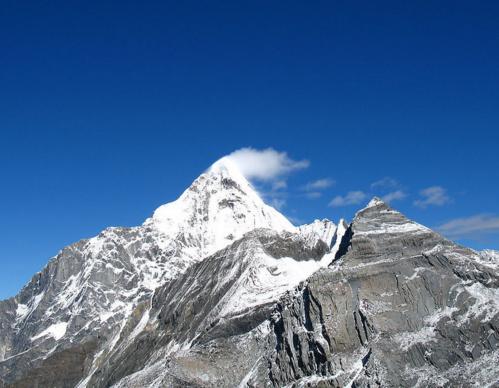
Mount Erguniang, located in the south of Mount Siguniang Scenic Area, is adjacent to Mount Daguniang, with an altitude of 5,454 meters. It is located at the junction of Xiaojin County and Wenchuan County. It is the peak of Mount Qionglai in the Hengduan Mountains. Every summer, the mountains and plains are full of green trees and grasses and you can see rare animals living in the canyons of the Tibet Platea, and you can also find many precious Chinese medicinal materials grown in the area. Mount Erguniang is steep, with narrow peaks and snow all year round. It is a good place for outdoor activities.

Mount Sanguniang, located in the middle of the Mount Siguniang Scenic Area, is 5,664 meters above sea level, and about 200 kilometers away from its west to Chengdu. The Mount Sanguniang Scenic Area has beautiful scenery, complex landforms, and is rich in flora and fauna, of which, the giant panda is the most famous, and there are also Tibetan and Qiang ethnic cultures.
The peaks of Mount Sanguniang are sharp and steep, and the peaks are as narrow as castles and covered with snow all year round. By the way, the World Research Center for Conservation of Giant Pandas Wolong Nature Reserve is located in the Mount Sanguniang Scenic Area. If you like cute pandas, you should not be absent from the mount here.
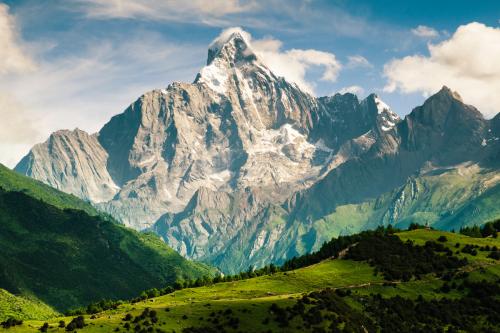
Mount Yaomeifeng, located in the northernmost part of the Mount Siguniang Scenic Area, is 6,250 meters above sea level, second to the height of Mount Gongga in Sichuan Province. As the most beautiful and slim one, Mount Youmeifeng is crowned as the “King of Mount Shu” (Shu is the abbreviation form of Sichuan Province), “Queen of Mount Shu” and “Sacred Mountain of the East”. It is a good place to take photos with blue sky and white snow.

Shuangqiao Valley, located in the northwest part of the Mount Siguniang Scenic Area, is 34.8 kilometers long and covers an area of 216.6 square kilometers. The name of Shuangqiao Valley actually refers to two bridges that the local people built in the valley to facilitate their passage.
One of them is made of willow wood, commonly known as the Willow Bridge; the other is made of red cedar, commonly known as the Bian Bridge(a bridge convenient for you to visit the scenery). There are birch forests, poplar forests, and green maple forests that are common in low mountain areas, as well as high-band spruce, fir, redwood, and patches of sea buckthorn, shrubs, and larch in Shuangqiao Valley at an altitude of 400 meters.
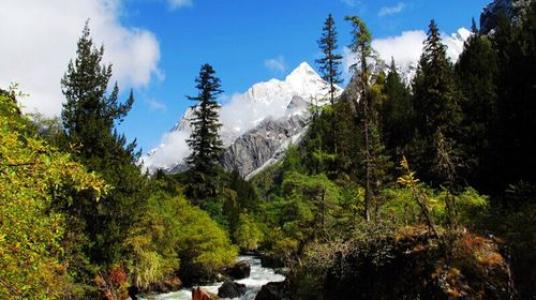
Changping Valley, located in the northeast of the Mount Siguniang Scenic Area, is 29 kilometers long and has an area of about 100 square kilometers. It is one of the main scenic spots of Mount Siguniang. There are not only beautiful natural scenery in the valley but also unique Tibetan ethnic customs.
It is said that Changping Valley is a paradise for amateur outdoor enthusiasts. The valley is filled with virgin forests and glaciers and is an excellent venue for sub-extreme sports.
Haizi Valley (Ocean Son Vally), located in the eastern part of the Mount Siguniang Scenic Area, is named “Haizi Valley” because of its numerous lakes. The valley is 19.2 kilometers long and covers an area of 126.48 square kilometers. This scenic area is flat with native meadows and is the birthplace of the Zanla River(one branch of Dadu River, which is one branch of Min River—branch of Yangtze River) and has been preserved since ancient times. In fact, Haizi Valley is the most beautiful valley among the three valleys of Mount Siguniang.
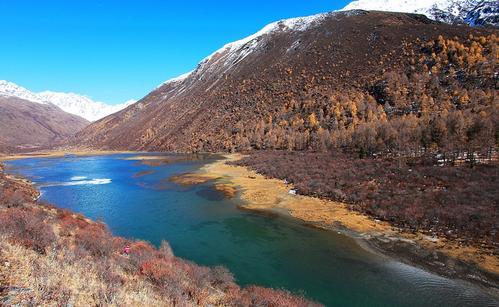
Its scenery is completely different from the other two valleys. It is not as simple as Shuangqiao Valley and not as narrow as Changping Valley. Haizi Valley can only be visited by walking or horse-riding due to the long distance. If you want to enjoy all its scenery, it usually takes a day.
However, if you are a true beauty lover, it is recommended that you stay overnight in the valley to truly enjoy the beautiful scenery.
Notice: Inside the scenic spot, there are sightseeing vehicles in Shuangqiao Valley and Changping Valley. Visiting the Shuangqiao Valley, a tourist bus throughout the journey is needed. The route runs from the Tourist Reception Center to the terminal station—Changheba; The Changping Valley tourist bus runs from the Tourist Reception Center to the Lama Temple (about 7 kilometers), and then you can choose to continue the tour on foot or horseback riding.
There is an ancient and moving legend about the origin of Mount Siguniang. Long long ago, a couple gave birth to four beautiful daughters. When they grew up, a bad demon who did bad things all the time came to the family and wanted to take the four girls as his wives.

The girl’s father was killed while fighting with the bad guy. Therefore, the four girls are determined to avenge their father’s death. First, the eldest girl and her husband went to fight the demon. Unfortunately, they were defeated. Then the second girl and her husband went to fight the demon and they failed, too. And finally, the third girl rushed to help, but was also defeated.
But they turned into three big mountains pressing on the demon after the battles. At this moment, the youngest girl came to assist holding the Mirror of Sun and Moon and pressed on the demon and she turned into a majestic mountain.
The mirror has turned all the snow on the four girls into a thousand years of ice and snow which made them as hard as ice-burg and finally crushed the demon to death.
The four girls traded their lives for peace. Therefore, to commemorate them, people call these four peaks “Mount Siguniang” (Four Girls Mountain).
Day 1: Take the shuttle bus from Chengdu to Mount Siguniang Scenery Area→Mount Siguniang→Shuangqiao Valley (Double-bridge Valley) Scenic Area (Yinyang Valley→Sun Moon Mirror→Five Colored Mountain→Ginseng Fruit Valley→Millennium Seabuckthorn Forest→Bonsai Shoal→Siguniang Tree King→Huyu Valley→Hunter Peak→Eagle Mouth Rock→Potala Peak→Dumu Peak→Ayu Peak→Savage Peak→Redwood Forest→Yutu Peak)
Day 2: Take the sightseeing bus into Mount Siguniang→Changping Valley Scenic Area (Lama Temple→Dry Tree Beach→Pomiao Peak→Shagluo Glacier→Red Stone Array→Wooden Mule→Glacier on the South Side of Yaomei Peak→Camel Peak)
Take a bus to Niu Pengzi (牛棚子) →climb to the Ayu Mountain or other peaks in Shuangqiao Valley(Double-bridge Valley)→go back on the same day
Start from Mount Siguniang→ walk or ride through the Jipengzi →set up a camp in Dacao→ return to the camp after climbing the Mount Siguniang (5,355 meters above sea level) on the second day→ return to Mount Siguniang Town on the third day
Route 1: Drive to the Lama Temple→ walk or ride a horse to Shangganhaizi → set up camp on the first day→ climb Mount Siguniang or other nearby peaks from the second day to the sixth day → return on the seventh day
Route 2: Drive to the Lama Temple→ walk or ride a horse to the Lianghekou to set up camp on the first day→ go up the Lianghekou→ climb Pomiao Mountain or other peaks from the second to the fifth day → return on the sixth day
Route 3: Drive to the Lama Temple→ walk or ride a horse to Tuzhu Valley or Zhenggou Dam to camp on the first day→ climb the Yangmantai Mountain or Camel Peak from the second to the fourth day → return on the fifth day
Mount Siguniang is worth visiting all the year-round. There are more visitors in spring and autumn, followed by summer and winter.
July and August are the best time to travel to Mount Siguniang. At that time, the mountains are full of flowers, blooming like brocade, and you can go down to the ditch to feel the coolness of the snow-capped mountains.
Besides, from mid-October to mid-November, the scenery of Mount Siguniang is like intoxicating wine. Please pay attention to the big temperature difference between the top and the foot of the mountain. If you go to the mountain during this period, you’d better take a coat with you.
Take bus 82 in Chengdu City to the Chadianzi Bus Station to take the long-distance shuttle bus for Xiaojin County. Mount Siguniang is on the way to Xiaojin County.
The fare of the long-distance shuttle bus is 95 yuan, and the whole journey takes 4-5 hours. Do remind the driver of your destination.
Chinese: 请带我去茶店子客运站。English: Please take me to the Chadianzi Bus Station.
You need to go to the Chadianzi Bus Station from Chengdu Railway Station to take the bus to Mount Siguniang as there is no bus directly heading for the mount. The fare is about 20 yuan.
You can directly take a taxi to Xiaojin County in Chengdu City and then take the shuttle bus to your destination, but the transportation fee would be expensive about 1000-1500 yuan.
